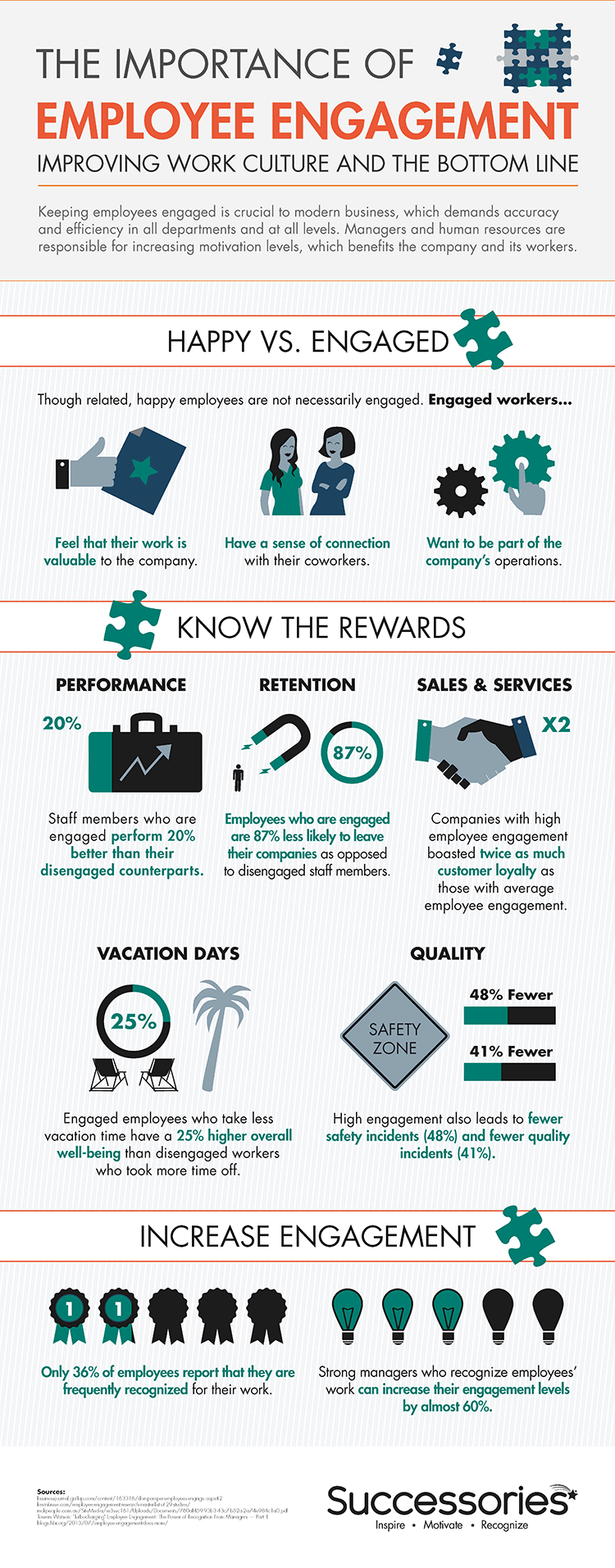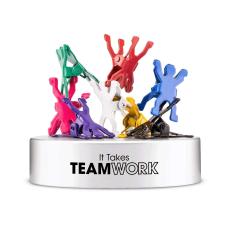Employee Engagement Infographic
The Importance of Employee Engagement
Keeping employees engaged is crucial to modern business, which demands accuracy and efficiency in all departments and at all levels. Managers and human resources are responsible for increasing motivation levels, which benefits the company and its workers.
Happy vs. Engaged
Though related, happy employees are not necessarily engaged. Engaged workers… feel that their work is valuable to the company, have a sense of connection with their coworkers, want to be part of the company's operations.
Know the Rewards
Staff members who are engaged perform 20% better than their disengaged counterparts. Employees who are engaged are 87% less likely to leave their companies as opposed to disengaged staff members. Companies with high employee engagement boasted twice as much customer loyalty as those with average employee engagement.
Engaged employees who take less vacation time have a 25% higher overall well-being than disengaged workers who took more time off. High engagement also leads to fewer safety incidents (48%) and fewer quality incidents (41%).
Increase Engagement
Only 36% of employees report that they are frequently recognized for their work. Strong managers who implement employee recognition awards can increase their engagement levels by almost 60%.
How to Get Higher Employee Engagement?
Many business owners make the mistake of thinking that if they go through the motions and put a few trappings in place, like ping pong tables in the break room, or a healthy snack option vending machine, that’s all it takes. Unfortunately, that’s putting the cart before the horse. Those things can enhance a company’s culture if it’s already brimming with deeply engaged employees, but by themselves, those trappings can’t actually create engagement.
An engaged employee is someone who shares the company’s core values and understands not just the company’s mission, but also how their particular job helps push the company closer to its strategic objectives. That then, implies two things: Better and clearer communication from you, and recognition when your employees reach specific milestones that move you closer to your objectives.
If you don’t yet have an employee recognition program, then a great way to give your employees the autonomy they’re craving is to form a committee, drawing members from the ranks of the employees themselves, and let them play a major role in setting up the recognition program.
Remote Employee Engagement
Gallup.com recently conducted an extensive survey relating to employee disengagement. The results reveal a few surprises and on the heels of the survey, the company also published some ideas for helping to ensure that your employees don’t suffer that fate.
Once an employee feels genuinely disengaged, odds are excellent that they’ll simply leave for greener pastures. Below, we’ll summarize both:
First, the biggest surprise was the fact that a staggering 76% of employees experience burnout at least some of the time, with 7% reporting that they are extremely burnt out and on a constant basis, and 21% of employees reporting that they feel burnt out quite often. Only 4% of employees report that they are never burnt out.
If an employee does suffer feelings of burnout, they are 63% likely to use a sick day, even if they’re not sick, and 23% of burnt out employees suffer side effects so severe that they have to visit the emergency room.
It gets worse. Since the global pandemic has forced many traditional office workers into their homes, employees are experiencing burnout relatively more often than they have in the past. Further, the fact that most of your employees are now working remotely complicates your job as a manager in a variety of ways.
Most managers assume that the best way to fix the issue is to provide additional time off or ease back on the number of hours an employee has to work in order to get the job done. Unfortunately, this is a myth.
Although total hours worked does have some bearing, how people experience their workload has a stronger influence on burnout than the raw number of hours worked. In other words, how you manage your employees plays a huge role in whether or not they experience burnout. The top five reasons that employees ultimately feel disengaged are:
- Unfair treatment at work
- An unmanageable workload
- Unclear communication from management
- Lack of manager support
- And unreasonable time pressure
As you can see from this list, most of the things that lead to employee disengagement are caused by specific actions (or inaction) by management. Fixing that starts with taking an honest look at how you manage your people to understand whether or not you are guilty of any of the above, and if you are, taking immediate steps to correct those behaviors.
In terms of unclear communication, the easiest way to improve things on this front is to use multiple communications channels. Email alone isn’t enough. You should be reaching out to your team via phone and text message, as well as utilizing some type of video conferencing solution like Zoom, Skype, or Google’s Meet.
In addition to that, be sure that not all of your communications with your employees are strictly work related. Humanize your approach and take the time to engage in personal conversations. This can be as simple as sharing a meme or forwarding a funny joke you received.
If you do that, and keep your work-related communications clear by only including one salient point per work-related email, and further, if you take the time to evaluate your other potentially harmful behaviors as mentioned above, you’ll go a long way toward reducing the chances that your employees will suffer from burnout.













